Plaza de Panama | |
|---|---|
 The plaza in 2014 | |
| Coordinates: 32°43′54″N117°9′1″W / 32.73167°N 117.15028°W |
Plaza de Panama is a plaza in Balboa Park's El Prado Complex in San Diego, California. [1] [2] [3]
- View of Plaza de Panama from street, 2024
Plaza de Panama | |
|---|---|
 The plaza in 2014 | |
| Coordinates: 32°43′54″N117°9′1″W / 32.73167°N 117.15028°W |
Plaza de Panama is a plaza in Balboa Park's El Prado Complex in San Diego, California. [1] [2] [3]

The Panama–California Exposition was a world exposition held in San Diego, California, between January 1, 1915, and January 1, 1917. The exposition celebrated the opening of the Panama Canal, and was meant to tout San Diego as the first United States port of call for ships traveling north after passing westward through the canal. The fair was held in San Diego's large urban Balboa Park. The park held a second Panama-California exposition in 1935.
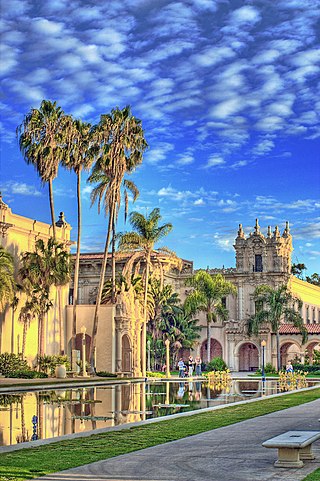
The California Pacific International Exposition was an exposition held in San Diego, California, during May 29, 1935–November 11, 1935 and February 12, 1936–September 9, 1936. The exposition was held in Balboa Park, San Diego's large central urban park, which had also been the site of the earlier Panama–California Exposition in 1915.
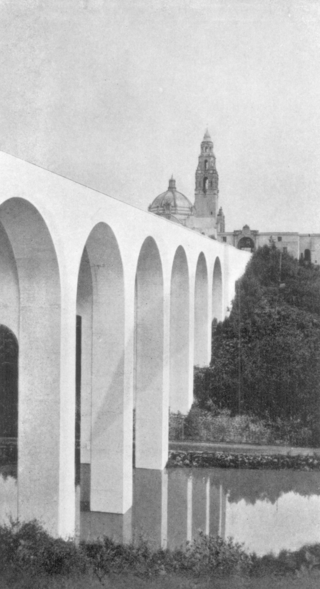
The Cabrillo Bridge is a historic bridge in San Diego, California, providing pedestrian and light automotive access between Balboa Park and the uptown area of San Diego. It was built for the Panama–California Exposition of 1915. The bridge was nominated for the National Register of Historic Places in 1976 and was named a Local Historic Civil Engineering Landmark by the American Society of Civil Engineers in 1986.

The Spreckels Organ Pavilion is an outdoor venue that houses the open-air Spreckels Organ in Balboa Park in San Diego, California. With more than 5,000 pipes, the Spreckels Organ is the world's largest pipe organ in a fully outdoor venue. Constructed for the 1915 Panama–California Exposition, it is located at the corner of President's Way and Pan American Road East in the park.

Downtown San Diego is the central business district of San Diego, California, the eighth largest city in the United States. It houses the major local headquarters of the city, county, state, and federal governments. The area comprises seven districts: Gaslamp Quarter, East Village, Columbia, Marina, Cortez Hill, Little Italy, and Core.
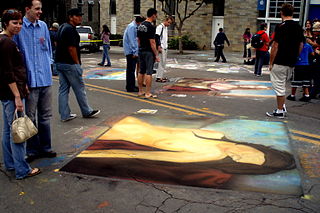
The culture of San Diego is influenced heavily by American and Mexican cultures due to its position as a border town, its large Hispanic population, and its history as part of Spanish America and Mexico. San Diego's longtime association with the U.S. military also contributes to its culture. Present-day culture includes many historical and tourist attractions, a thriving musical and theatrical scene, numerous notable special events, a varied cuisine, and a reputation as one of America's premier centers of craft brewing.
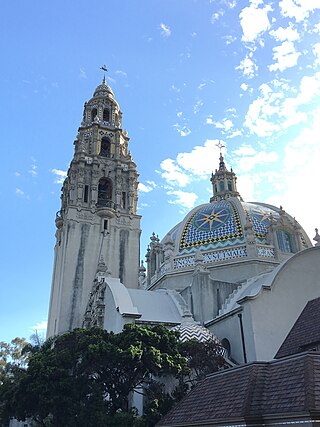
The Museum of Us is a museum of anthropology located in Balboa Park in San Diego, California. The museum is housed in the historic landmark buildings of the California Quadrangle.

The San Diego Art Institute was a contemporary art museum with a focus on artists from the Southern California and Baja Norte region. It was founded in 1941 as the San Diego Business Men's Art Club. Its name was changed in 1950 to the San Diego Art Institute. In 1953, women were admitted for membership. It officially became a nonprofit in 1963. The San Diego Art Institute in Balboa Park and Lux Art Institute in Encinitas merged in September 2021 to become the Institute of Contemporary Art, San Diego, with each museum continuing to operate at its respective site.

The Mingei International Museum is a non-profit public institution in Balboa Park in San Diego, California, that collects, conserves and exhibits folk art, craft and design. The museum was founded in 1974, and its building opened in 1978. The word mingei, meaning 'art of the people,' was coined by the Japanese scholar Dr. Sōetsu Yanagi by combining the Japanese words for all people and art.

Balboa Park is a 1,200-acre (490 ha) historic urban cultural park in San Diego, California. Placed in reserve in 1835, the park's site is one of the oldest in the United States dedicated to public recreational use. The park hosts various museums, theaters, restaurants, and the San Diego Zoo. It is managed and maintained by the Parks and Recreation Department of the City of San Diego.

The Japanese Friendship Garden is a Japanese garden in Balboa Park in San Diego, California. It is an expression of friendship between San Diego and its sister city Yokohama.

Zoro Garden is a six-acre sunken garden in Balboa Park in San Diego, California. It is located between the Fleet Science Center and Casa de Balboa. The name refers to the Persian mystic Zoroaster.

The California Quadrangle, California Building, and California Tower are historic structures located in Balboa Park in San Diego, California. They were built for the 1915–16 Panama–California Exposition and served as the grand entry to the event. The buildings and courtyard were designed by architect Bertram Goodhue. They were added to the National Register of Historic Places on May 17, 1974. They now house the Museum of Us.

El Prado Complex is a historic district in Balboa Park in San Diego, California. The 13-acre (5.3 ha) complex includes 13 contributing buildings and one contributing structure. Most of the structures were built for San Diego's Panama–California Exposition of 1915–16 and were refurbished and re-used for the California Pacific International Exposition of 1935–36. The original architects were Bertram Goodhue and Carleton Winslow. The area was listed on the National Register of Historic Places in 1976.
The following is a timeline of the history of San Diego, California, United States.

Horton Plaza Park is an outdoor plaza in downtown San Diego, California. It includes an amphitheater, retail stores, and a fountain. It is located on the corner of 4th Avenue and Broadway.
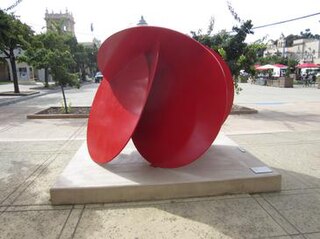
Odyssey III is an abstract 1973 painted aluminum sculpture by Tony Rosenthal, installed outside the San Diego Museum of Art in San Diego's Balboa Park, in the U.S. state of California.
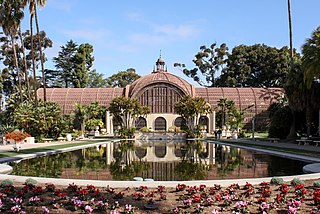
The Botanical Building is a historic building in Balboa Park in San Diego, California. Built for the 1915–16 Panama–California Exposition, it remains one of the largest lath structures in the world. Alfred D. Robinson (1867–1942), founder and president of the San Diego Floral Society, suggested the construction of a lath house as a feature of the Panama–California Exposition, which was to open in the City of San Diego on January 1, 1915.

Bea Evenson Fountain is an outdoor fountain in San Diego's Balboa Park, in the U.S. state of California.
Morley Field Sports Complex is a sports complex in Balboa Park in San Diego, California. The sports complex was named after John Morley, who served as a park superintendent in Balboa Park from 1911 to 1939.